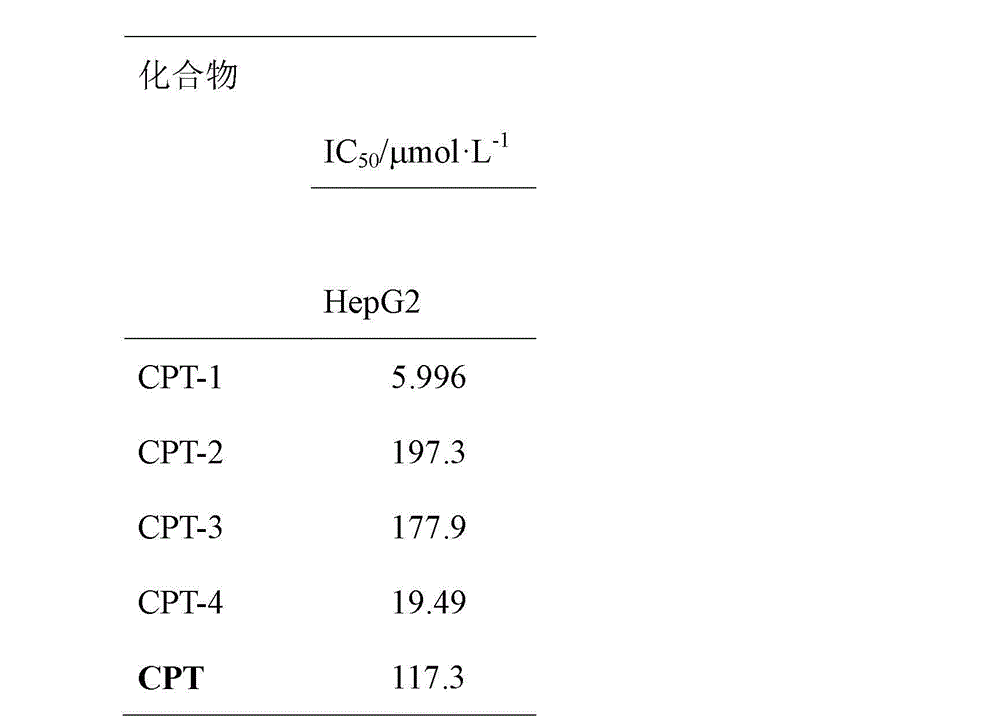Synthesis and application of four new conjugates of camptothecin-steroid
A camptothecin and conjugate technology, applied in the field of synthesis of new camptothecin-steroid conjugates, can solve the problem of destroying the integrity of the E ring
- Summary
- Abstract
- Description
- Claims
- Application Information
AI Technical Summary
Problems solved by technology
Method used
Image
Examples
Embodiment 1
[0031] Preparation of 20(S)-O-3β-hydroxy-5-androstene-17β-acylcamptothecin (CPT-1)
[0032] Add 3β-hydroxy-5-androstene-17β-carboxylic acid (280 mg, 0.88 mmol) and anhydrous dichloromethane (30 mL) into a 100 mL reaction flask, stir and dissolve at room temperature, and then add EDC HCl (200 mg, 1.04 mmol), DMAP (213 mg, 1.75 mmol) and camptothecin (100 mg, 0.29 mmol). Stir the reaction at room temperature under the protection of argon, and monitor it by TLC. After the reaction, pour into a separatory funnel and add 50 mL of dichloromethane, then wash with 0.1 mol / L HCl and saturated brine respectively, dry the organic layer with anhydrous magnesium sulfate, and concentrate The organic layer was concentrated and the residue was subjected to pressure column chromatography v (chloroform): v (methanol) = 150:1~50:1 as the eluent to obtain the product (CPT-1).
[0033] The product (CPT-1) is a yellow powdery solid (75 mg, yield 40.2%), mp: 268-271 ℃; 1 H NMR (CDCl 3 , 600 MHz) ...
Embodiment 2
[0035] Preparation of 20(S)-O-3β-acetoxy-5-androstene-17β-acylcamptothecin (CPT-2)
[0036] Add 3β-acetoxy-5-androstene-17β-carboxylic acid (317 mg, 0.88 mmol) and anhydrous dichloromethane (30 mL) into a 100 mL reaction flask, stir to dissolve at room temperature, and then add EDC HCl separately (200 mg, 1.04 mmol), DMAP (213 mg, 1.75 mmol) and camptothecin (100 mg, 0.29 mmol). Stir the reaction at room temperature under the protection of argon, and monitor it by TLC. After the reaction, pour into a separatory funnel and add 50 mL of dichloromethane, then wash with 0.1 mol / L HCl and saturated brine respectively, dry the organic layer with anhydrous magnesium sulfate, and concentrate The organic layer was concentrated and the residue was subjected to pressure column chromatography v (chloroform):v (methanol)=150:1~50:1 as the eluent to obtain the product (CPT-2).
[0037] The product (CPT-2) is a yellow-white powdery solid (85 mg, yield 42.8%), mp: 235-238 ℃, 1 H NMR (CDCl 3 ...
Embodiment 3
[0039] Preparation of 0(S)-O-androst-4-ene-17β-acylcamptothecin (CPT-3)
[0040] Add androst-4-ene-17β-carboxylic acid (278 mg, 0.88 mmol) and anhydrous dichloromethane (30 mL) into a 100 mL reaction flask, stir at room temperature to dissolve, and then add EDC HCl (200 mg, 1.04 mmol), DMAP (213 mg, 1.75 mmol) and camptothecin (100 mg, 0.29 mmol). Stir the reaction at room temperature under the protection of argon, and monitor it by TLC. After the reaction, pour into a separatory funnel and add 50 mL of dichloromethane, then wash with 0.1 mol / L HCl and saturated brine respectively, dry the organic layer with anhydrous magnesium sulfate, and concentrate The organic layer was concentrated and the residue was subjected to pressure column chromatography v (chloroform): v (methanol) = 150:1 ~ 50:1 as the eluent to obtain the product (CPT-3).
[0041] The product (CPT-3) is a yellow-white powdery solid (85 mg, yield 45.8%). mp: 253-256 ℃, 1 H NMR (CDCl 3 , 600 MHz) 8.40 (s, 1H),...
PUM
 Login to View More
Login to View More Abstract
Description
Claims
Application Information
 Login to View More
Login to View More - R&D
- Intellectual Property
- Life Sciences
- Materials
- Tech Scout
- Unparalleled Data Quality
- Higher Quality Content
- 60% Fewer Hallucinations
Browse by: Latest US Patents, China's latest patents, Technical Efficacy Thesaurus, Application Domain, Technology Topic, Popular Technical Reports.
© 2025 PatSnap. All rights reserved.Legal|Privacy policy|Modern Slavery Act Transparency Statement|Sitemap|About US| Contact US: help@patsnap.com


